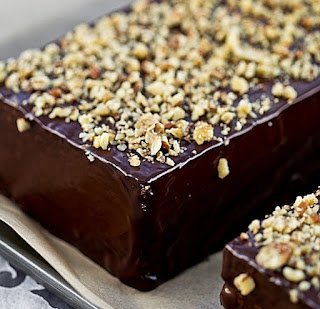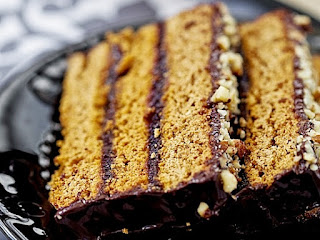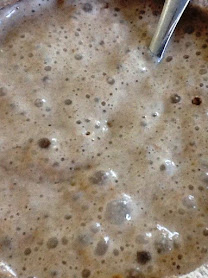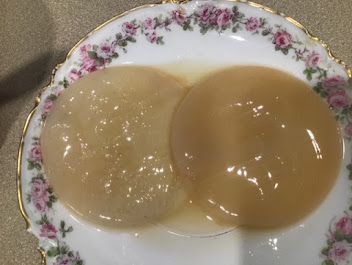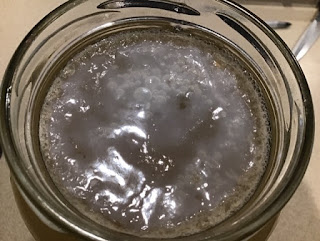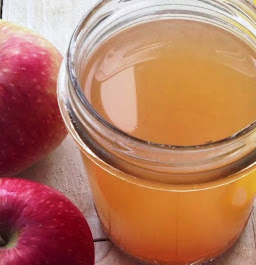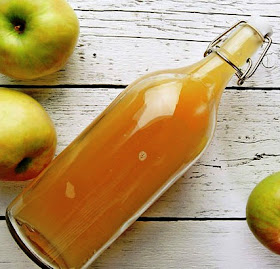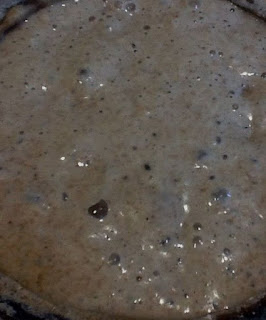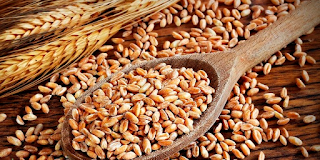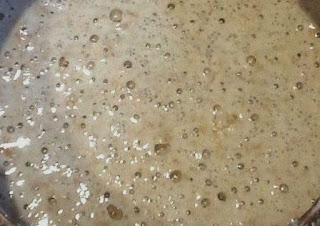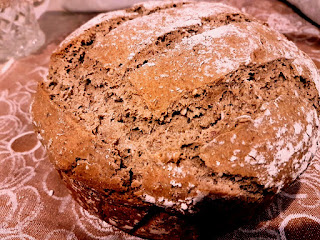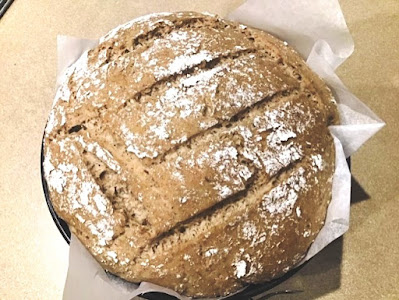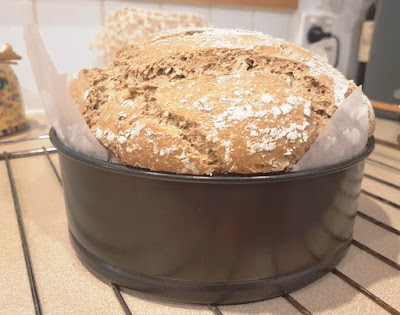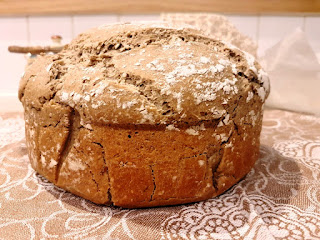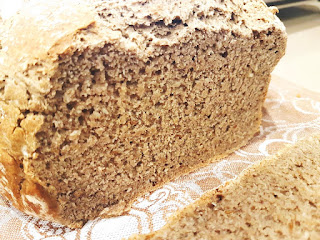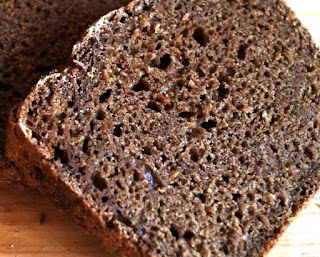LIVE PROBIOTIC
Traditional Live Fermentation Cultures and Sourdough Bread Baking for Life and Vitality
Monday, November 23, 2020
Traditional Old Slavic Polish Christmas Pryanik
Wednesday, October 7, 2020
KOMBUCHA MUSHROOM INSTRUCTIONS
Brew moderately strong black or black/green tea in a pot, ceramic container or glass jar. 1 tea bag of black tea can be used for 2 L of boiling water.
Add 3 Table spoons of sugar (any type) per 1 L of tea, dilute and cool. Sugar should be diluted when you place the mushroom in the tea, as it might cause burns/damage to the culture.
Add Kombucha Scobie to the brew. It will sink to the bottom or might be floating on the top, both being normal. Eventually, it should rise to the surface and stay there.
Cover lightly, co the culture can breath, otherwise the fermentation wont happen.
5. Place in a dark well ventilated place in the kitchen away from direct sunlight and strong smells. Leave for a week, then check if the brew started to sour (ferment). In summer, at room temperature 24 C and higher, it takes 3-4 days to produce the fizzy drink. It may take longer in winter.
The mushroom will grow to the size of your glass jar/container and can be kept indefinitely. It will produce more layers and new baby mushrooms.
Dark yeast flakes in the liquid are normal. They can sediment at the bottom of container.
Honey can be used to flavor the drink after it was brewed, but don’t replace sugar for it as the culture will die over time.
Herbal teas can be used, but not more than 50% of total tea volume (50% black tea/50% green or herbal tea).
Use a small amount of lemon juice to speed up fermentation, but better leave for a week and longer (it will get more fizzy) in a dark warm place.
SOURDOUGH STARTERS INSTRUCTIONS
When received, you should open the bags/jars straight away, and transfer the contents to a clean glass jar (at least 300 ml volume) or any other container (not plastic or metal) that you will use to keep your Starter in. You will feed the Starter in this container at least once a week (even if you do not bake at that time), so the container should be large enough to accommodate approximately 1/4-1/3 a cup1 of Starter culture and enough space for 1-2 feeds (extra 1/4 a cup), plus some more space to allow the air in and to account for possible expansion.
1st Stage of Starter Activation (Feeding): 2-4 hours.
Add 1 Table spoon of flour2 and clean (filtered or cooled boiled) water, enough to create a runny mixture, similar to pancake dough. Stir to encourage air circulation needed for fermentation3. Cover lightly with cotton towel. This is the .
Leave for 2-4 hours in a warm place (25 C+). Stir from time to time to allow air in, and if the mixture starts to thicken (if you use the flour with high fiber content), add more water. The mixture should be very runny liquid at this stage.
The first signs of life will appear, as the yeasts start waking up. Do not expect the bubbles and big expansion at this stage.
Brown liquid or thin white foam can be formed on top. Mix them in, do not throw them away. The smell should be pleasant and not off. The mixture might look and feel “lighter”, as the yeast has started to feed on it and change its structure.
2nd Stage of Starter Activation (Increasing): 2-4 hours.
Add 1Tea spoon of flour if you only feed the Starter without the intention to bake now, or 3-4 Table spoons of flour if you are increasing it for baking. Add water to the runny consistency as in 1st Stage. You will have approximately 1 and 1/3 - 1 and 1/2 Cups of Starter.
Leave for 2-4 hours, depending on room temperature. As the yeast gets more active and hungry, the mixture will get airy and bubbly, showing the porous structure when lifting with a spoon. The Starter is expected to expand at this stage4.
It might take longer to reach this point initially, but in future with fully active and happy Starter, it normally takes on average 4 hours in total to re-activate (feed and increase) the Starter after taking it out of fridge. This process will be further referred to as Full Cycle of Fermentation (FCF).
If you only feed the Starter, put it back to fridge, lightly covered. If baking, take 1 Cup of Starter to use for baking and put the rest to fridge until the next feed.
NOTE: If you’ve received the Starter dehydrated, add 1/4 Cup of water and let soak for 1 hour before following the 1st and 2nd Stages.
It is very important to transfer the Starter to a new container and feed it on the same day of receiving it, to give the yeast a better chance of surviving after transportation. If you are unable to do this for any reason, open the bag/jar and refrigerate the culture for up to 12 hours, attending to it as soon as you can.
To maintain the Starter, keep it refrigerated for a maximum a week (lightly covered), then it needs to be taken out and fed as per above 1st-2nd Stages.
When going away and unable to feed the Starter at least once a week, thicken it up by adding enough flour to form the dough, place in plastic bag or any container lightly covered, refrigerate for up to a month.5
For baking, take the Starter out of fridge at least 24 hours before you plan to bake.
If you want to make properly soured well-fermented traditional bread full of flavor, or if the room temperature is lower than ideal for the yeast activity (+25 C), take the Starter out of fridge and start preparing it earlier (24-36 hours beforehand) to allow the time for proper activation and longer fermentation periods at each proofings.
11 cup is considered 250 ml in these instructions.
2Wholegrain or Wholemeal Non-GMO, unbleached and preferably Organic flours should only be fed to the Starters. Gluten Free Starter can be fed with variety of Gluten Free flours, varying them at each feeding. Baking can be done with any flour of your choice. Rye Starter can be used to bake all types of breads, Spelt Starter can’t be used for Rye bread baking, as it might not properly leaven it.
3Metal utensils can be used, although the wooden ones are preferable. Avoid plastic.
4The Starters have shown the approximate expansion rates of 1:2.5-3.
5 Spelt Starter is less tolerant to long periods between feeds, hence requiring more regular feedings to avoid the yeasts dying (every 4-5 days).
CIDER SCOBIE INSTRUCTIONS
If the Cider Vinegar is prepared correctly, Cider Scobie will appear at the bottom of the container. It has the look of a jellyfish and contains the yeasts, good probiotic bacterias and enzymes.
The sweeter the sort of apples used for Cider, the more alcohol it will contain and the easier the creation of Cider Scobie.
The healing properties of Cider Scobie are 3 times higher than those of Apple Cider Vinegar itself.
Dont throw it away, keep it to enhance the healing qualities and accelerate your next batch of Apple Cider. Keep the Cider Scobie in Apple Cider.
If you dont have the Cider (you've just bought the Cider Scobie), you need to prepare it, so the Scobie doesnt dye. In the mean time, while the brew is getting prepared, keep the Scobie in Apple Cider liquid you've received it in (transfer from plastic bag to glass jar and keep lightly cover so it can breath).
You can use any good recipe of Apple Cider. I am offering my family recipe here.
Old Slavic Apple Cider Vinegar Recipe
Cut apples in small pieces including the skin and mash lightly. Place in enamel or glass container and add hot water (t about +70 C) to cover 3-4 cm above apples.
Add 2 Table spoons of Raw Sugar if using sweet apples, or 4 Table Spoons if using bitter apples. Very sweet apples dont require sugar addition. Sugar can be replaced with raw honey (1-2 Table Spoons). Mix to dilute.
Cover lightly, place in dark and warm place. The ideal temperature for Apple Cider fermentation is +26-35 C. Let sit for 2 weeks, stirring the mixture from time to time.
Drain the liquid. Transfer the Scobie to it, and leave for 2 more weeks.
The Vinegar will be ready to transfer to other containers. Dont shake the liquid. You can filter to clarify it if you wish. Keep some brew for the Scobie to live in!
Friday, August 16, 2019
Sourdough Culture Basics
Lactic bacteria and Wild yeast are predominate in healthy Starter, and it is important to maintain this balance. The Starter should smell sour, but not off, and be active, - which are two most important signs of healthy Sourdough Starter.
In each fermentation cycle, healthy Starter reaches its peak of activity (rises), then falls back to its normal level. If the peak is missed or not pronounced due to cool room temperature, or the presence of other microorganisms in the Starter that dominates Wild Yeast and Lactic Bacteria, - brown liquid will form on the top. Never throw it away. Mix it in and add more flour and water to "feed" the Starter, then leave it for 4-8 hours. At warm temperatures above 25 C, 4 hours is enough for healthy Starter to reach its peak.
The Starter can "learn" to work at cooler temperatures, which happened to all my Starters within a year after we relocated from QLD to VIC few years ago. It takes 1 hour for my Starters now to reach their activity peak at below 20 C room temperature.
It is very important to use Wholegrain Flour to "feed" the Starters to keep them healthy. White flour is too poor in nutrients to promote healthy microorganisms balance in Starters over a long time. Fresh home-milled flour is the best, and I treat my Starters with it at least once a month, if I can not "feed" it to them all the time.
The Fermentation Cycle is the time between "feeds", when Lactic Acid Bacteria and Wild Yeast grow and multiply in the Starter, and, - if left for too long, - undesirable bacteria and microorganisms may start growing ("over fermented", "soured" Starter). It can be cured, but better avoid it reaching this stage.
Wheat (Spelt) Starter is most vulnerable to getting overly fermented, as its gluten is very prone to breaking down. When not in use, keep it refrigerated at all times and "feed"twice a week. If you can not "feed" it that often, keep it in thicker consistency and "feed" once a week.
Working with traditional Wild Yeast Sourdough Starter can be more time consuming than using commercial yeast. You need to be patient, and after some time you will start recognizing its cycles and "feeding" needs better. It is similar to having a pet, whom you get to know better the longer you have owned and looked after.
Normally, the Starter that is about to starve has thick and fluffy upper layer with collapsed bubbles (showing as small holes on the surface), and the liquid forming at the bottom, which will rise to the top if you don't "feed" it immediately. The Starter is about to reach its peak and needs "feeding" to avoid getting sour. It will smell pleasant, but not sour yet, as the yeast levels are at their highest but the acid is not built up yet. Such Starter can be used for baking, or "fed" and put away until next time use.
The best suited for baking Starter is before it has reached its peak, or has just started to show bubbles.
Soured Starter can not be used for baking. If you missed the peak of your Starter's activity, and it has been over fermented (built up too much acid), "feed" it again and wait until the balance of its microorganisms returns back to normal.
If the Starter is left to sour without "feeding", the yeasts will start dying and smell will change to unpleasant. Although it can still be revived, the process could be complex and time consuming.
If the Starter is left neglected for too long, the mold will grow, showing as small white dots on the surface. It can no longer be used, or revived. Mold and unpleasant smell are the only signs of "dead" Starter.
If your Starter is not very active but smells good, "good" microorganisms dominate in it, so keep "feeding" it and adjust its consistency (water to flour ratio) and room temperature.
If you bake often and keep your Starter at room temperature, "feed" it once a day (Rye), and twice a day (Spelt and Wheat).
To "feed" the Starter that is kept refrigerated and not used for baking, take it out and let it go through full fermentation cycle (4-8 hours depending on room temperature and letting it reach the peak of its activity), then add a small amount of flour (1 tea spoon to 1/4 cup of Starter), mix, cover lightly and put back to fridge.
Active Starter ready to use for baking:
Tuesday, April 2, 2019
Activating Sourdough Starter - Don't Suffocate It
The signs of suffocation:
1. Appearance of surface crust or thick top layer, allowing pathogenic microorganisms growing underneath,
2. Sharp sour smell.
Please, follow the instructions, but if the type of flour you use is making the mixture too thick, add more water.
For those using oven on low setting to activate or "feed" the Starter, please, remember to use the rack.
Saturday, July 28, 2018
GLUTEN FREE SOURDOUGH BAKING
TRADITIONAL LONG FERMENTATION 100% GLUTEN FREE BREAD RECIPE:
This family recipe is for the bread baked in bread tin (loaf pan), which is also used for proofing. Any variety of Whole Gluten Free flours and their combinations can be used: Corn, Buckwheat, Millet, Quinoa, Oats, Potato, Rice, Sorghum, Flaxseed meal or Flax seeds, Arrow Root, Amaranth, Chia seeds, Poppy seeds, Pepitas, Sunflower seeds, Quinoa - whole seeds or meal.
1 Cup flour (1 Tea Spoon of Flaxseed or Chia seeds, or 1 Table Spoon Buckwheat flour),
2 Cups warm water (+1 Cup more),
1 Cup 100% Gluten Free Starter.
Mix well and leave in warm place for 4 hours to ferment. Add 1 cup more water if the mixture is thick (it needs to be moisture and watery), mix and leave for another 4 hours. The mixture will become porous and expand. It should not be too thick and dry.
2nd Dough:
3 Cups flour (1 Table Spoon of Flaxseed or Chia seeds or 1 Cup of Buckwheat flour),
1 Table spoons Salt,
1/4-1/3 Cup of Cold-Pressed Hempseed or Flaxseed oil (Olive oil can be substituted).
Add water and flour to Opara and mix well. The mixture should be watery (not dry). Leave for 4 hours to proof.
Before putting the trays inside the oven, heat it up to 180 C.
Sunday, July 8, 2018
TRADITIONAL OLD SLAVIC WHEAT SOURDOUGH BAKING
In Russia Emmer and Spelt used for porridge and bread were both amongst the most common in 17-18th century.
Spelt and Emmer are very similar wheat cultures, the latter is the botanical precursor of the former. They have different chromosome sets.
Emmer (Triticum dicoccum) originated in Mediterranean countries 5-6 thousands years B.C. The most ancient grains were found in Ararat Mountains in Turkey and later in Caucasus Mountains in Russia. It is the popular wheat in Italy, called Farro.
Emmer has 28 chromosomes, just like the hard wheat grain widely used our days (to make pasta and Semolina flour), but Emmer is non-GMO grown and can only be cultivated organically, being intolerant to chemical fertilizers.
Emmer has very rich vitamin and mineral content, very low gluten and low glycemic index. It has one of the highest fiber content of all grains.
Emmer has a pleasant nut flavour when used in cooking or baking. The bread from Emmer flour comes out drier and coarser.
Spelt (Triticum spelta) has been known since 5 thousands years B.C. in Ancient Egypt and Babylon. It is very similar by look and size to modern wheat grain.
It contains only 6 chromosomes. Spelt is the wild wheat variety that has never been genetically modified (GMO), so we have it now in its original natural state. Just like Emmer, Spelt does not tolerate any chemical fertilizers, and is very labour-intensive to cultivate.
Spelt has rich vitamin and mineral profile and the highest of all wheat varieties protein content. It also contains tryptophan amino-acid which gives the natural calming effect to nervous system.
Spelt grain has low glycemic index and very low gluten, which is lower than that of Barley and Oat grains.
Khorassan or Kamut (Triticum turgidum) is the ancient wild hard wheat variety, the cross of wild wheat with weed grasses. It is called the "Prophet's Grain" due to belief that Noah took it to his Ark according to Bible.
Khorassan grain is much larger in size than modern wheat grain. It has more distinctive aroma than Spelt, nutty flavour and the taste of pulses when used in cooking or baking.
Kamut has low level of oxidizing, so can be stored for longer than other grains and flours. Its nutritional profile is full of vitamins and minerals. It has very high protein and very low gluten content.
1 Cup flour,
2 Cups warm water,
1 Cup Starter
Mix well and leave in warm place for 2-4 hours to ferment. Stir from time to time to generate air circulation.
2 Cups flour,
1 Table spoons salt,
2 Table spoons of Cold-Pressed Hempseed or Flaxseed oil (Olive oil can be substituted),
Add salt and oil to water, mix well. Add Opara and, gradually, all flour. Mix well to form the dough. Flour your hands and knead it on floured surface for 5-30 minutes or refrigerate the dough for 1 hour before forming the loaves.
Form the loaves of desired shape (round or oval), place on greased trays. Leave to proof for 6-12 hours, depending on room temperature and on how well-soursed you prefer your bread to be.
Before putting the trays in oven, pre-heat it to 250 C. With sharp knife make a few light cross cuts at the surface. Spray the loaves with cool water.
Saturday, June 30, 2018
Kefir's Effect on Candida
It happens when the balance of "good" and "bad" bacteria in the gut is disturbed, which creates a favorable environment for Candida fungus to proliferate.
Kefir contains probiotic lacto-bacteria that "good" gut bacteria in human body "feeds" upon. Probiotics help to rebuild the normal micro-flora of the guts and prevent Candida growth.
The active cultures of Kefir speed up this process of natural balance recovery. It can also be taken for Candida prevention.
Freshly fermented Kefir contains the live cultures of acidophilus, bifido-bacteria and lacto-bacteria that prevent Candida growth, multiplication and generally stops its activity in the body. It also stops the Candida fungus from coming back.
I am vegetarian and don't eat dairy products, so I ferment my Kefir using Almond and Coconut plant-based milks using my dairy-free Tibetan Kefir Mushroom. It works wonderfully just as dairy milk.
Plant-based milks, especially Almond and Coconut milks can be used by people with lactose intolerance and by vegetarians.
Best Wishes,
Tatiana
Friday, October 27, 2017
How to Recognise Dead and Sick Kefir Mushrooms
Old Kefir Grains will not work any more producing healthy probiotic bacteria in milk. They will be on the way of healthy grains doing no work. Besides that, they will be decomposing making the milk go off adding off taste to the Kefir.
The grains that get old and become dead (or are dying) become flat, white (vs creamy colour healthy young grains), hard (vs soft young healthy grains) and stretchy.
In general, when Kefir grains get sick (and it can happen due to a number of reasons), they get stretchy and "snobby". The grains can get sick from being placed in the fridge for too long or at too cold temperature. If you pour too cold milk on them straight from the fridge every time you ferment Kefir, it will cause them go sick over the time.
They also can get sick from being exposed to too hot temperatures. The ideal temperature is room temperature 10-25 C.
They will also get sick if you don't replace milk and let them sit in soured milk for too long, or if it happens too often. Leaving them for 2-3 weeks in LOTS of milk while on vacations once ot twice a year won't do them harm, even if they sit in soured milk for some time.
Sick grains get old and die quickly. To preserve the culture over a long period of time, you need to make sure you look after it well.
Regardless of general opinion that the grains need to be well rinsed after each fermentation, it will not do them harm. Rinsing under chlorine water or under too cold or hot water will do them more harm than just straining Kefir and transferring them to a new bowl/jar of fresh milk. Remember, that milk is their medium. They don't like to be exposed to water too much.
Good luck with your culture!
Any questions, please, ask in the form below.
Sincerely,
Tatiana
Tuesday, August 30, 2016
CHEMICAL COMPOSITION OF TIBETAN MUSHROOM
NUTRITIONAL VALUE
Kefir grains are a gelatinous community of bacteria and yeasts in a matrix of proteins, lipids, and sugars. The fungus looks like white firm monolith of soft cheese or cauliflower. The baby-fungus is 5-6mm in diameter and reaches 40-50mm in diameter before dividing.
The dominant microflora are Saccharomyces kefir, Torula kefir, Lactobacillus caucasicus, Leuconnostoc species, lactic streptococci and lactose-fermenting yeast. The lactobacilli got their name from their chief by-product, lactic acid. These organisms can be found on the surface of nearly every plant. Lactobacillus species are also found in our mouths, intestines, and birth canals.
A European doctor, Dr Johannes Kuhl, conducted one of the foremost studies of lactic acid. In his research he discovered that Kefir was very high in lactic acid. Consequently, found that well-balanced diet with liberal amounts of lactic acid fermented foods was good protection against cancer.
KEFIR VS YOGHURT
Kefir is very similar to Yogurt. The main difference is that kefir curds have a small surface tension. This allows the curds to be easily broken into small pieces. The small curd size gives Kefir a liquid consistency.Kefir contains several major strains of friendly bacteria not commonly found in Yogurt: Lactobacillus Caucasus, Leuconostoc, Acetobacter species, and Streptococcus species. It also contains beneficial yeast, such as Saccharomyces kefir and Torula kefir, which dominate, control and eliminate destructive pathogenic yeast in the body. They do so by penetrating the mucosal lining where unhealthy yeast and bacteria reside, cleansing and strengthening the intestines. Hence, the body becomes more efficient in resisting such pathogens as E. coli and intestinal parasites.In addition to beneficial bacteria and yeast, Kefir contains minerals and essential amino acids that help the body with healing and maintenance functions. The complete proteins in Kefir are partially digested and therefore more easily utilized by the body.
Tryptophan, one of the essential amino acids abundant in Kefir, is well known for its relaxing effect on the nervous system.
Kefir also offers an abundance of Calcium and Magnesium, which are also important minerals for a healthy nervous system. Kefir in the diet has a particularly profound calming effect on the nerves.
Kefir's ample supply of Phosphorus, the second most abundant mineral in our bodies, helps utilize carbohydrates, fats, and proteins for cell growth, maintenance and energy.
Kefir is rich in Vitamin B1, B12, amino acids, Folic acid and Vitamin K. It is an excellent source of Biotin, a B Vitamin that aids the body's assimilation of other B Vitamins, such as Folic acid, Pantothenic acid, and B12. The numerous benefits of maintaining adequate B vitamin intake range from regulation of the kidneys, liver and nervous system to helping relieve skin disorders, boost energy and promote longevity.
HOW THE MUSHROOM HEALS
Our diet is mostly composed of "dead (cooked) food", which petrifies in our intestines and poisons us from inside, poisoning the blood. The death is indeed "made by man".
Kefir, made with LIVE TIBETAN MUSHROOM brings microflora of intestines into balance and takes out the toxins built up in the body.
- Enhances immune system
- Plays a vital role in the development of a healthy digestive tract in babies, as it protects against negative effects of radiation and helps improve the immune system
- Helps to relieve lung infections
- Helps to normalise metabolism and loose weight by breaking the fat globules down
- Neutralises and takes out of the body heavy metals, salts, chemical antibiotics, kidney stones, pathogene microorganisms
- Kefir culture produces a series of natural proteins and protein fragments, called peptides, that may have an inhibitory effect on less desirable bacteria
- Undesirable bacteria that reside in the intestines produce certain enzymes that turn certain dietary substances into potential carcinogens. The friendly-flora of Kefir actually reduces the levels of these carcinogenic enzyme substances
- Kefir is the strongest and the only harmless natural antibiotic of our days. Kefir's friendly cultures also produce specific antibiotic substances, which can control undesirable microorganisms and act as an anti-carcinogenic factor
- Kefir is the strongest natural remedy against any allergy
- Inhibits cancer cells
- Cleans blood vessels
- Normalises appetite
- Cures stomach uclers
- Energy booster
- Has youthful effect on skin
- Strengthen hair
- Helps to lessen the effects of taken pharmaceutical antibiotics
- Lowers blood sugar
- Normalises blood pressure
- Has youthful effect on the body cells
- Kefir also helps to enhance bowel function and control Candida - a condition where there is an excessive growth of yeast cells
- Lactic acid bacteria fight pathogenic organisms: Salmonella typhi die; escherichia coli are unable to develop, and S. paratyphi and Corynebacteriae diphtheriaae lose their pathogenic properties.
TRADITIONAL OLD SLAVIC RYE SOURDOUGH BAKING
1 Cup flour,
2 Cups warm water,
1 Cup Starter
Mix well and leave in warm place for 2-4 hours to ferment. Stir from time to time to generate air circulation.
2nd Dough:
2 Cups flour,
2 Table spoons salt,
Add salt, sugar, molasses, Rye Malt brew and oil to water, mix well. Add Opara, seeds and then, gradually, all flour.
Wet the loaves tops and cover with seeds (optional). Heat oven to 150 C before palcing the trays in. Bake for 1 hour.
Take the loaves out of oven and transfer on to a wooden board, rack or cotton towel, turning them upside to cool for 3-6 hours before cutting.


